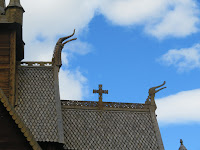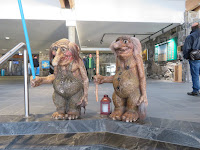 We also happened upon the infamous General Motors plant in Lordstown Ohio. This is one of the GM plants that have been in the news recently due to the strike by the United Auto Workers. All GM's plants have seen activity organized by the UAW, but the Lordstown plant has received special attention because it was closed by GM. Since 2018 GM has been steadily reduceng the workforce at the Lordstown plant laying off entire shifts as GM continues to change its focus to electric vehicles rather than small fossil fuel vehicles like the Cruze, which is one of the vehicles manufactured here. The last day of production in Lordstown was March 6, 2019, and it has been one of the poster children for the UAW's negotiations with GM which eventually resulted in the current strike.
We also happened upon the infamous General Motors plant in Lordstown Ohio. This is one of the GM plants that have been in the news recently due to the strike by the United Auto Workers. All GM's plants have seen activity organized by the UAW, but the Lordstown plant has received special attention because it was closed by GM. Since 2018 GM has been steadily reduceng the workforce at the Lordstown plant laying off entire shifts as GM continues to change its focus to electric vehicles rather than small fossil fuel vehicles like the Cruze, which is one of the vehicles manufactured here. The last day of production in Lordstown was March 6, 2019, and it has been one of the poster children for the UAW's negotiations with GM which eventually resulted in the current strike.
On the way to Brooksville Pennsylvania, we stopped on the border with Ohio near Sharon PA. There we found Seneca, the 6th Whispering Giant carved by Peter Wolf Toth. Carved in February of 1973, it looked surprisingly well, despite 46 years of weathering in the harsh norther climates. We were pleased not to be shut out as we were in Akron.
 Other than being on our route and allowing us to visit Seneca,
Brooksville had no particular draw for us other than it was on our route. We
did visit the historic downtown and the river walk, and also discovered the
Sculpture Rocks Heritage Park. In 1912 Douglas Stahlman began inscribing rock
surfaces around Brookside with inscriptions from the bible. By 1913 he had hand
chipped more than 540 biblical inscriptions in various locations around
Brooksville, and held religious meetings at the sites. While impressive, the
locals found it creepy, and eventually committed Stahlman as insane.
Other than being on our route and allowing us to visit Seneca,
Brooksville had no particular draw for us other than it was on our route. We
did visit the historic downtown and the river walk, and also discovered the
Sculpture Rocks Heritage Park. In 1912 Douglas Stahlman began inscribing rock
surfaces around Brookside with inscriptions from the bible. By 1913 he had hand
chipped more than 540 biblical inscriptions in various locations around
Brooksville, and held religious meetings at the sites. While impressive, the
locals found it creepy, and eventually committed Stahlman as insane. About a half hour from Brooksville was Punxsutawney PA. Since
I had many times in my life tried to find out whether Punxsutawney Phil had
seen his shadow, I couldn’t be that close to the town where he lives and not
stop by. Sadly, we were there on a Sunday, to the Punxsutawney Weather Discover
Center wasn’t open to visit – on these steps each year we find out just how
many more weeks of winter there may be.
About a half hour from Brooksville was Punxsutawney PA. Since
I had many times in my life tried to find out whether Punxsutawney Phil had
seen his shadow, I couldn’t be that close to the town where he lives and not
stop by. Sadly, we were there on a Sunday, to the Punxsutawney Weather Discover
Center wasn’t open to visit – on these steps each year we find out just how
many more weeks of winter there may be. We moved on to Williamsport PA, where we found the wealthiest
communities in the US in the 1800’s. Because of the lumber resources in the
area, the 1800’s found Williamsport having the most millionaires per capita of
any community in the United States. We strolled Millionaires Row where most of
these lumber barons chose to build their mansions. While locals attempt to make
it vibrant with B&B’s and restaurants, it still looks like none of those
1800’s era lumber barons would choose to live here now.
We moved on to Williamsport PA, where we found the wealthiest
communities in the US in the 1800’s. Because of the lumber resources in the
area, the 1800’s found Williamsport having the most millionaires per capita of
any community in the United States. We strolled Millionaires Row where most of
these lumber barons chose to build their mansions. While locals attempt to make
it vibrant with B&B’s and restaurants, it still looks like none of those
1800’s era lumber barons would choose to live here now. In Williamsport, Chief Woapalanne was the 65th
Whispering Giant carved in October 1989. Woapalanne was originally placed at
the at the entrance of Brandon Park in central Willaimsport for all to see and
enjoy. Sadly, like many other we are searching for, time took its toll, and the
base of Woapalanne was severely damaged by termites. Woapalanne was originally
28 feet tall, and looked like this.
In Williamsport, Chief Woapalanne was the 65th
Whispering Giant carved in October 1989. Woapalanne was originally placed at
the at the entrance of Brandon Park in central Willaimsport for all to see and
enjoy. Sadly, like many other we are searching for, time took its toll, and the
base of Woapalanne was severely damaged by termites. Woapalanne was originally
28 feet tall, and looked like this. Thanks to the citizens of Williamsport and their politicians’
will, Woapalanne was removed from Brandon Park and refurbished. Sadly, the base
of Woapalanne could not be refurbished, the deterioration was too complete. But
the now 24-foot-tall Woapalanne proudly stands next to the Williamsport transit
depot. I could only find references to the Brandon Park location, but thanks to
the Woman’s excellent Google search work, we managed to score this one – bonus!
Thanks to the citizens of Williamsport and their politicians’
will, Woapalanne was removed from Brandon Park and refurbished. Sadly, the base
of Woapalanne could not be refurbished, the deterioration was too complete. But
the now 24-foot-tall Woapalanne proudly stands next to the Williamsport transit
depot. I could only find references to the Brandon Park location, but thanks to
the Woman’s excellent Google search work, we managed to score this one – bonus!
Talk to you soon.














































